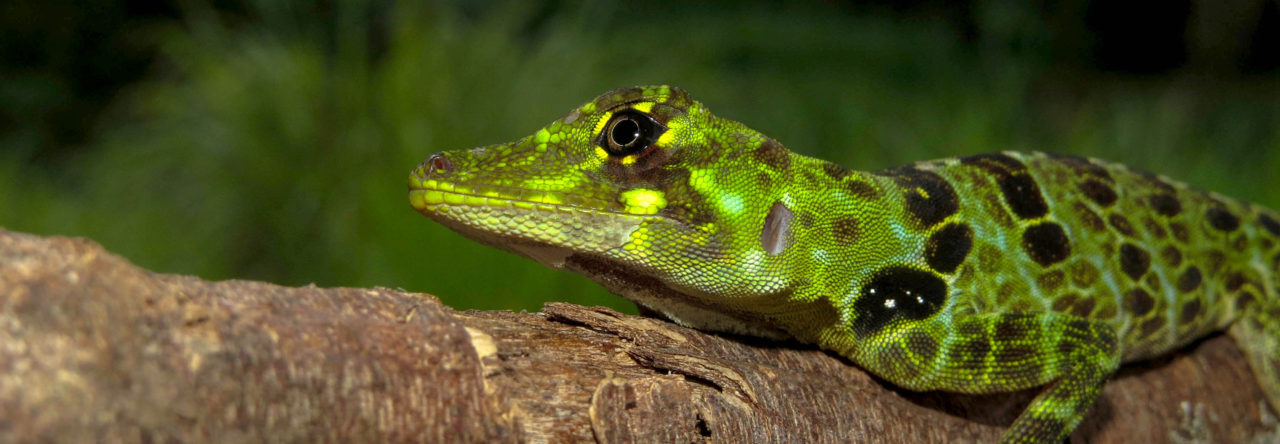As I prepared for our current trip to Ecuador to study the natural history of Phenacosaurus orcesi, I feared that we would not find any lizards. After all, until recently, the species was known from only two specimens. What if we simply couldn’t find them?
These fears were assuaged when I reviewed the literature—scant as it is—on phenacosaur ecology. In the most comprehensive study, Miyata found 77 P. heterodermus individuals in blackberry bushes in five afternoons of observations at a site near Bogota. On seeing the previous AA post, Vic Hutchison also recalled finding P. heterodermus in blackberry bushes in Colombia. George Gorman mentioned to me that he collected phenacs in a suburb of Bogota in the summer on 1968, and he recalls that “it was a like Lesser Antillean experience…rather than a ‘mainland’ experience, in that the lizards were abundant, easily collected, and on fenceposts and hedges.” In addition, the original description of P. vanzolinii states that “the local people say that the ‘camaleon o camaleon’ is common in the fields of maize.”
From all of this information, I formed the hypothesis that finding phenacs would be easy, that we’d be awash with data and would finish so early that we could go traipsing off elsewhere in Ecuador. In other words, I set myself up for the Principle of Unsympathetic Magic to rear its ugly head, and it did so with a vengeance.
We’ve had no trouble finding P. orcesi at night—our current count is somewhere north of 30 (compared to the dozen or so specimens previously collected of this species!). This has been great for examining their stomach contents, measuring their body proportions, and running them on a portable racetrack to measure sprint speed. But we’d also like to get data on where they occur when they are awake. And it has turned out, contrary to expectation, to be basically impossible to find them during the day. Score another one for the Principle of Unsympathetic Magic. Even going to the exact same places where we find them at night, look as we might, we couldn’t come up with a single lizard. If I had a nickel for every blackberry bush I’ve scoured…Where do they go? What are they doing? Frustrating!
Fortunately, we’ve found a way around this. Led by Melissa Woolley and Anthony Herrel, we (mostly they) have gotten up before dawn to return to the sleeping sites of P. orcesi so as to be there when they climb out of bed, and then to follow them through the course of the day. Indeed, Melissa and others have followed some lizards dawn-to-dusk, and as a result, we are now getting an idea of what these lizards do—with all kinds of interesting surprises. But that’s the topic of another post…
- Third Mexican Amber Anolis Lizard Discovered - January 14, 2025
- Anolis Lizard Research Paves the Way for Advances in Treatment of Human Prostate Cancer - January 10, 2025
- When Two Lizards Meet for the First Time, Scientists Witness Evolution in Action - January 3, 2025



Rafael Moreno
Hello, I am expectant to know what these lizards do during day. Track a lizard during day was something I always wanted to do with A. heterodermus. Well, when I wanted to study the population dynamics of A. heterodermus near to my hometown Bogota, I had to search them at day. Although to follow lizards will give you lights about what they do during the day and how to find them, I would like to share some natural history aspects about A. heterodermus that I found (unfortunately papers about these aspects are still under review) that may be useful for finding A. orcesi at day. These lizards are easier to find them between 10-11 and 14-15 hours, at the edge of the forest on sunny vertical branches or thin trunks between. Adults prefer perch heights between 1.50-3.00 meters and juvenile prefer perches below one meter. Also some plants where lizards like to stay are Miconia, Xilosma, Myrchianthes and Chusquea. I hope that my comments are useful in your quest.
Melissa Woolley
Thank you for your comments, Rafael! We were in Quito at the time of your post, but I do see how your suggestions would have helped – it does sound appropriate for A. orcesi. We only found one during the day – but I spotted it while filming others nearby. In the end, we filmed 4 individuals from dawn to dusk, and several more for 1 to 6 hours (all found on their perch from the night before). More details to come after several hours of video review!